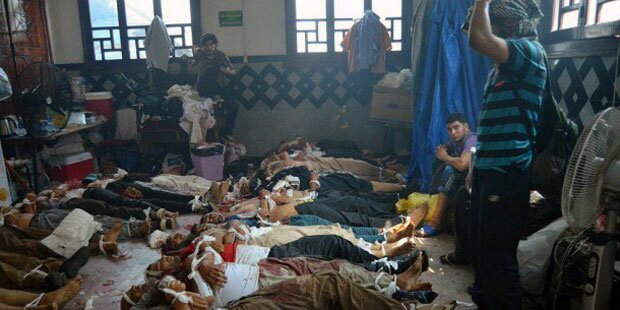In Cairo morgues, the bodies are piling up, and not merely due to the scale of army massacres. Almost unbelievably, the government is trying to force unwilling families to sign falsified death certificates: their murdered children ‘committed suicide.’
Zeinhom morgue has become an obligatory destination here, though it is a dreaded building that people in Cairo once refused to drive past, shied away from even mentioning by name. Today, they stand outside it in long lines, frantic to recover the bodies of loved ones.
The lines of relatives began here after the army dispersal of the sit-in supporting deposed president Mohamed Morsi in Rabaa al-Adawiya Square on Wednesday, August 14. The massacre in Ramsis Square brought new arrivals, then the 36 prisoners killed in Abu Zaabal prison, and finally the massacre of the Central Security Forces (CSF) in Sinai, which left 25 people dead the following day.
The killings have overwhelmed Zeinhom; the morgue has never before seen such traffic. The lines of families outside put the detested gas-station lines of the Morsi era to shame. Inside, there are not enough refrigerators to hold the dead, so they lie on the floors and in the corridors, covered with ice to hold back decomposition for a time.
At times as many as 50 ambulances have pressed in one after another, carrying their loads of corpses. The morgue, short of pathologists, can only perform 10 autopsies at once; there are only four autopsy rooms here. The morgue’s normal maximum capacity was once about 50 corpses at a time.
The breakdown in the system is a horror. To be preserved, a human body needs to be kept just above freezing, between 4 and 5 degrees Celsius, and cannot be kept that way for more than a month; after that the body begins to decompose, and then to rot. This has become the central problem at Zeinhom in the morgue’s daily work, as it tries to deal with all of the disputed or unidentified bodies.
The vicinity of the morgue is shrouded in black, by the mourning clothes and darkened hearts of the families. Sobbing grief fills the spaces between the buildings, the wails of women. The agony of bereavement is written across the faces, men and women alike.
Bodies fill the floors inside the morgue, wrapped in bloodstained white cloth. There, a lone family member is covering one of the bodies with ice, hoping to ward off decomposition while he waits for the autopsy. Others are volunteering inside the morgue, helping the staff carry the bodies, disinfecting surfaces, and spraying air freshener to cover the unbearable smell of decay that fills the building.
“Suicide” is the only cause of death that to allows relatives to take a body out of the morgue for burial. Witnesses here showed Al-Akhbar such death certificates, which they had refused to sign. And so the bodies continue to pile up here, most of them showing obvious signs of disfigurement.
Witnesses who had volunteered to wash bodies in the morgue said the victims from Abu Zaabal prison clearly had faced more than just tear gas [the official account]. They told Al-Akhbar that the dead men had obviously been tortured, some with electricity. “Some of the victims had been savagely wounded, some partially skinned,” we were told. “The discoloration of the corpses, black and blue, was the result of asphyxiation and of decomposition. This indicates that the victims had died more than a day ago.” They had not suffocated on tear gas, and had died days before.
Despite the accounts of numerous witnesses, the Interior Ministry has refused to respond to these allegations. Egyptian human rights advocates maintain that the detainees killed in Abu Zaabal were tortured, and then burned to hide the evidence. They have called for an international-not Egyptian- investigation of the event.
The massacre, in which the authorities admitted that 36 detainees were killed, was widely decried. However, human rights advocates say that pathologists at the morgue are trying to cover up this “crime committed by the Interior Ministry.” A crime that amounts to systematic murder, with total impunity, as Al-Akhbar was told.
Rania Rabih al-Abd
27 Aug 2013




































